The same evolution of organization and dress as the line infantry experienced were seen in the light infantry. The uniform during the revolutionary period was almost identical to that of the line, with only blue stockings or trousers and colored eppauletes distinguishing the dashing light infantry of the time. New uniforms were introduced in 1801, with shakos and plumes added. The shako was redesigned in 1810, with cords and plumes eliminated (but this order was rarely complied with). In 1812 the new jacket without lapels was introuduced. Some jackets had pointed cuffs and some square. Most had pointed lapels.
The center companies of light battalions were chasseurs and the elite heavy companies were carabiniers. In 1800 the light battalions had eight companies of chasseurs and one of carabiners. In 1804 elite voltiguer companies were added in place of one company of chasseurs. In 1808 the nine company structure was changed to six companies - one of carabiniers, one of voltiguers, and four of chasseurs.
The facing distinctions of the various companies remained constant throughout the period, although there were many regimental variations. Shako plumes were often replaced by pom poms on campaign. Colonels wore white plumes, Majors red over white, and Chef de Battalions red. Company officers wore the distinctions of their companies.
Chasseurs wore green epaulettes with red crescents, Hessian boots with red, green, or white tassels, green shako cords, green or green with red tipped plume, and red collars and cuffs with white piping.
Carabiniers wore solid red epaulettes, Hessian boots with red tassels, red shako bands and chevrons, red shako cords, red plumes, red collars with white piping, and blue cuffs with white piping.
Voltiguers wore green epaulettes with red crescents or yellow epaulettes with green crescents, Hessian boots with white, yellow, red, or green tassels, yellow shako bands and chevrons (although this was not regulation) green with yellow tipped or yellow with red tipped plume, and buff or yellow collars and cuffs with red or white piping.
For a long time no light infantry was available in 1/72 scale. HaT Industries has released two sets that will cover most of the period. Their 1805/6 Light Infantry are suitable for the period from 1801-10. The French Light Infantry wear the 1812 uniform and can be used for the period 1812-5. This leaves a gap of a couple of years, but the gap can be easily filled by attaching heads from the latter set to bodies of the former.
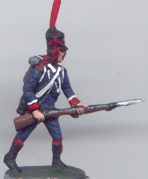 |
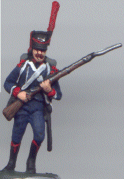 |
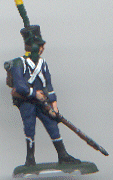 |
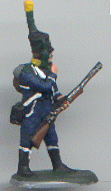 |
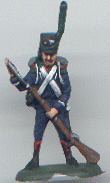 |
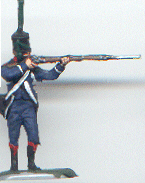 |
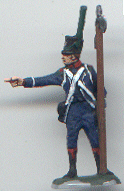 |
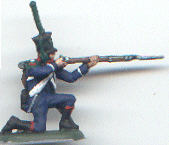 |